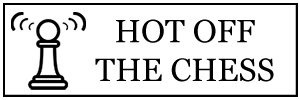
The eighth round in the Altibox Norway Chess Tournament 2016, very much belonged to Levon Aronian. The Armenian Grandmaster came in to the round and would dash the hearts of the home crowd by beating their chess hero, and World Champion, Magnus Carlsen.
Carlsen had of course beaten Vladimir Kramnik in the previous round, playing a nice game, and taking sole lead of the tournament. Most would have expected him to come in to this game, looking to play solidly with the Black pieces and to consolidate his lead at the very least. This was not to be.
Aronian chose the English Opening, and as much as I love this opening, I did not hold great hope for this game. It is an opening that Carlsen knows very well, and regardless of what was to happen in the game, I would be curious as to what Aronian’s expectations were. They surely could not have been that Carlsen would put up such little resistance.
As the game went, Carlsen’s novelty of 10…Na5 (diagram 8.1, above) was slightly strange. 10…Nd4 and 10…Nxe5 had been tried previously, and my guess is that Carlsen just wanted to get out of book. I’m not sure though in this case, a novelty for the sake of it is rarely a good idea I think. It’s ok to be out of the box, but there at least should be an out of the box concept there. Carlsen’s move purely puts a Knight on the rim in my opinion, at least I can’t see any idea there. However, I don’t even pretend to be able to see things that Magnus Carlsen sees, so please let me know if he has given some insight about this move that I have missed.
If Aronian was thrown by it, he didn’t show it and continued to develop calmly. There came 11.Qc1 Qc7 12.Nd2 Ne8 13.f4 Nd6. To be quite honest, I was wondering if Magnus Carlsen might have been abducted by aliens and they had an imposter playing. His opening just was not making sense to me. I am all for experimentation, but the repeated Knight moves were just helping White. We chess players, are not brought up having it drummed into us not to move the same pieces twice in the opening for nothing.
Of course all rules are meant to be broken and there are many well established openings which do it. However, there are good reasons; it is constructive. In this case, it was very hard to see the good reasons or what this was doing for Carlsen’s cause. Aronian had been handed the initiative, and he seized it with both hands. Soon Carlsen’s knight on a5 was under pressure and this resulted in his Queenside pawns being busted. He was soon a pawn down and with doubled a-pawns to boot. The diagram, below, shows the situation that Black soon found himself in.
White has just re-captured a rook on d1 and things are difficult already for Black. It is hard to know what to play, White is looking very threatening with his e-pawn and activity. Black’s first thought has to be how to take up an active defence, to try and activate bishop and rook somehow. This is not easy to do, however, perhaps …Bg4 or …Bh3 is all he has. Carlsen opted for 26…Qxe5? and this did not help his cause in the slightest.
Aronian pounced with 27.Rd8+! Carlsen’s goose is cooked. After 27…Kf7 (27…Kg8 28.Ne6+ is decisive, with Rf8 or Qf8 to follow, depending on what Black plays) there came 28.Qf3+ Bf5 (28…Qf5 gives White 29.Qxf5 gxf5 and White has Black in a bind) 29.Rxb8 Qxb4 30.g4 Qb4 31.Nd3 and Black resigned. A strange game from the World Champion, and one which would see him relinquish sole lead and be joined by Aronian on 5/8.
Chess is known for its brilliancies and powerful tactics, its theoretical surprises; sometimes, however, where a point goes can boil down to subtle differences. This was to be seen in Pavel Eljanov’s game versus Li Chao. Eljanov played the London System, a perfectly respectable choice, but one which requires White to play responsibly. The London System is very much like the Reti, in that it is very easy for White to become bogged down or passive if they don’t have a plan. This goes for all openings, of course, but some are less forgiving than others. As things were, Eljanov was doing fine, and playing confidently. His 9.g4 was a fine illustration of this.
As can be seen in the diagram, above, there is a tense situation going on in the centre of the board, and there followed: 9…fxe5 10.dxe5 Be7. In hindsight, perhaps this move was a little too quiet and the bishop was not a very pretty piece there on e7. An alternative was 10…Bb4 with 11.c3 (11.gxf5 Bxd2+ =) 11…Bxc3 12.bxc3 Bg6. This looks a little nicer to me, Black has managed to exchange his dark-squared bishop, but I suppose on the other hand, White is ready to lunge his h-pawn forward and Black might not have liked that very much, especially with the d-pawn. However, White really must be very careful as to his King safety, as it can’t go to the Queenside and if he’s going to be throwing his pawns forwards on the Kingside, there is going to be some air there if Black managed to get active along the d-file.
Compare this with the way things actually went in the game. After 10…Be7, there followed the natural 11.gxf5 exf5 12.Rg1 and here White has an obvious initiative. In addition to lacking development, Black now has the semi-open g-file and a passed pawn to deal with. Actually, Li Chao did manage to tidy up a little on the Kingside, and achieve some activity, but White had a very good presence on both wings. Extremely flexible.
Returning to the matter of subtle differences, however, this was ultimately what decided the game. In the above diagram, Black has just played …Kf7, escaping check. As you can see, Li Chao has given up his Queen for a White rook, and a couple of passers. The game should actually be a draw, but here, White makes a fatal error – 37.Qa7+?
The reason as to why this is an error becomes clear after 37…Re7 38.Qf2+ Ke8. White has no more checks, and Black is ready to Queen. After 39.Qe1 Black can push on with 39…g4! Stopping both of these passed pawns is going to be extremely difficult, and this proved true in the game, as Eljanov was soon resigning. By contrast, had he instead played 37.Qb7+, the outcome will most likely have been half a point better for him. The reason being that after 37…Re7, White can check on d5, f3, and most importantly still has access to Black’s back rank, namely the a8-square. A7, b7, hardly any space between them at all, but what a huge difference one can make from the other.
Vladimir Kramnik had lost to Magnus Carlsen in the previous round, and was a point and a half off the pace coming in to this round. So, if he wanted to be in with the slightest, remotest (still-needing-a-miracle) of chances in this tournament, he had to win his game against Pentala Harikrishna. At least he would have the White pieces.
He clearly came out to try something and be a little unorthodox, his 1.Nf3 leaving his development flexible, and taking his opponent on positionally rather than theoretically. Though Harikrishna did not fail in his task miserably, the approach worked for Kramnik and when the Queens came off the board, he was left with the kind of position he likes – an unquestionable edge to work with and grind out.
Kramnik was almost flawless from here, a pair of rooks were exchanged, after which the activity of White’s remaining rook and Knight dominated. Harikrishna never stood a chance to be quite honest and just found himself completely out-manoeuvred.
The two remaining games were drawn. Maxime Vachier-Lagrave and Veselin Topalov in a Berlin Defence, which saw Black obtain the two bishops and active rooks along the e-file. It wasn’t really enough for anything, however, and Topalov gave sacrificing the exchange a try. This was a viable idea because Vachier-Lagrave himself was not very active and just seemed to be hanging about. White quickly gave the rook back for one of the black bishops, and the game quickly headed towards a draw, nothing really eventful.
Black equalised quickly in the semi-slav of Giri-Grandelius. However, no sooner had the tension in the position built, it quickly fizzled again. White kamikaze’d a piece on f6, which opened Black’s King, but the Dutchman quickly sought repetition and this arrived on move 29. Neither player seemed intent on getting up to anything to be honest.
Just one round remaining, then. Just how costly will Carlsen’s loss in this round prove to him? Can he recover? He will have White against Pavel Eljanov in the final round. And what about Levon Aronian — can he capitalise on Carlsen giving him a foot in the door? Well, he will have the Black pieces against Pentala Harikrishna in the final round and might have his work cut out for him.
Standings after 8 rounds:
Aronian, Carlsen — 5
Vachier-Lagrave, Topalov, Kramnik — 4½
Li Chao, Harikrishna — 4
Giri — 3½
Eljanov — 3
Grandelius — 2
Round 9: Friday 29th April
Grandelius—Vachier-Lagrave
Carlsen-Eljanov
Topalov-Kramnik
Li Chao-Giri
Harikrishna-Aronian
Play begins at 16:00 local time. If you need to, you can check your time, here.
More Information: Atibox Norway Chess 2016 Website
